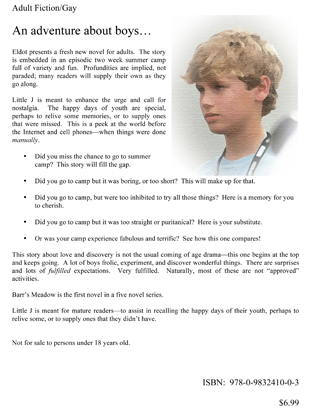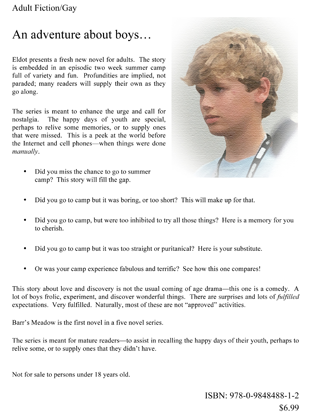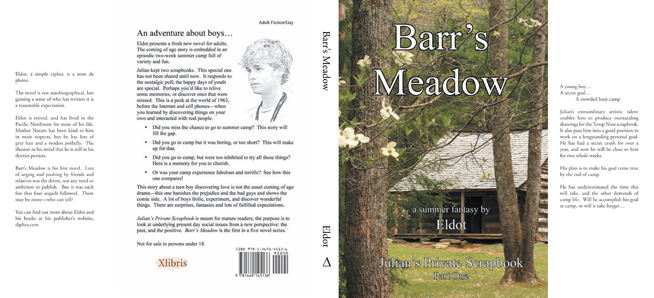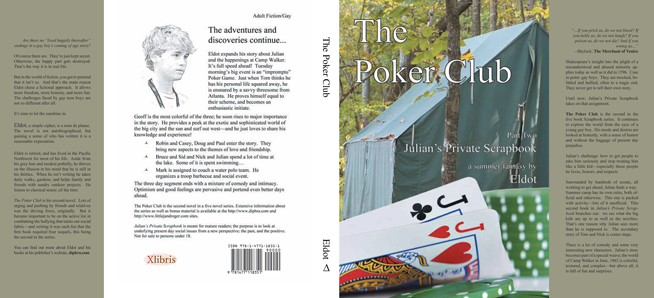The five book titles in the two series are the same—
Barr’s Meadow: Julian’s Private Scrapbook, Part 1
The Poker Club: Little J and Roger, Book Two
The Poker Club: Julian’s Private Scrapbook, Part 2
The Shooting Gallery: Little J and Roger, Book Three
The Shooting Gallery: Julian’s Private Scrapbook, Part 3
Thunder and Lightning: Little J and Roger, Book Four
Thunder and Lightning: Julian’s Private Scrapbook, Part 4
The Champions: Little J and Roger, Book Five
The Champions: Julian’s Private Scrapbook, Part 5
but the books themselves are not the same. Herewith is an essay to explain the difference, and why the individual titles were left unchanged.
We begin with a flashback in time. Even though friends and relatives had been urging me to write for some time, writing a novel on this or any subject was a notion I never entertained. I did not felt the need or the motivation; I was not convinced I could do such a thing as write a novel. Most of my experience was in analytic prose and editorial composition. Fiction was too daunting—my idea of what writing a novel would entail and require had kept me from considering it seriously. That attitude changed rather abruptly one evening as I sat watching the news on television.
The trigger:
Sometime in 2006, a local news item was handled with typical sensationalism and bluster. It was one of those occasional “alleged” molestation stories about a coach who is accused of having a sexual relationship with one of the athletes.
Its formulaic holier-than-thou clucking was more offensive than usual. It was clear that the reporter or writer of the feature was out for scandal mongering above all, and that the true story was not a concern. Tabloid trash, pure and simple.
Those stories are rarely if ever treated honestly. In the first place, concern for the victim is not the motivator. In the second, they are eager to trash an alleged offender regardless of the true facts. Peoples’ lives are damaged in the process, and the social fabric is smeared rather than cleansed.
The media had once again played prosecutor, jury and judge in a kangaroo court that allows no defense. The innocent are not protected, and the guilty may or may not have been discovered and punished.
But those were never the purpose of the reporting.
I have known individuals who have been victimized by the media, and am always offended and outraged when I see what may be yet another abuse by our so called free press. That was the original motivator for writing Little J and Roger.
The reaction:
I created two characters to illustrate a story that might have been told if the media were out to tell the truth. It was extrapolated from real persons and their experiences. It was not meant to tell any particular person’s story, so it was thoroughly fictionalized. The nature of the relationship itself is the main issue; the individual persons are component parts.
Character 1: The predator: an adolescent develops a crush on an adult.
Character 2: The victim: a vulnerable adult gets caught.

The story: how does the adolescent plan and achieve his/her seduction objective? That was the original core of Little J and Roger. The story set out to explore the characters and examine how and why they functioned as they did. No pre-judgments or moralizing was allowed. These characters were examined in their own terms and on their terms. They were treated with sympathy and support, for the most part. The story could have been either heterosexual or homosexual. The latter was chosen; the whys of that decision is another subject altogether and will not crowd this essay.
So: Little J and Roger is about an illegal relationship: what is its nature, how did it come about, and what would its outcome likely be? It was placed in a setting that allowed time and opportunity to focus on aspects that are never otherwise examined. It was looked at directly and indirectly. Contrast and comparison with other relationships provided a context that maximized opportunities to consider love as a theme as well as a topic.
A secondary or companion issue was needed to give the main story depth and dimension. The issue of teen suicide provided the ideal companion. The number of adolescents that end their lives because of self-identity problems and social bullying is appalling. The media, of course, fails to take or get credit for its role in helping to create the hostile world that the teen can’t cope with.
In Little J and Roger a variety of personality types and circumstances were assembled to illustrate the coming of age process as it governs what boys do. The context in which they were placed, a summer camp, was chosen because it was a convenient way to remove the social prejudices of the everyday world and maintain an illusion of plausibility. The setting enables these characters to be seen as they are and as they could be. These are the boys that in the real world become the victims of bullies and prejudice.
Placing them in a happy place is a bit of a novelty, perhaps, but it serves the purpose of keeping the focus on the characters: what they need and are doing rather than on the usual fare of mean, hostile forces and the often tragic outcome of their story.
Alas, the real world...
Shortly after the final eBook in the series was published, offers to put out print editions were received. The process of preparing both hard and paperback versions was begun. Soon, such open candor about this subject caused an unexpected reaction in some quarters—to say the least.
Back to previous page
an odd thing happened
The Revised Edition story
For a little more than a year I was courted by print publishers. They were very regular in contacting me by e-mail and telephone. I’m not sure how this came to be, but it must have been because I made inquiries about agents and publishers as I was nearing completion of the first book in the Little J and Roger series.
At last, in October 2011, I was ready. All five books were published in electronic book editions, and my confidence in their quality was sufficient. I took the plunge, so to speak. I had spent some time examining various features and proposals, and a Canadian firm seemed to be the best, overall. They had been one of the first to contact me, and they had been regularly touching base to encourage me to become one of their authors. Every few months I would get an e-mail or a phone call.
I decided, finally, to sign. I sent the money and signed the contract. I was assigned an author account manager, and I had a lengthy conversation with him on the telephone. I filled out the detailed author questionnaire he sent. He called again, effusive and supportive. He asked me to complete the submission list and send the manuscript in. I had a few format questions that the form did not address, so he asked me to send an example from the book so that he could better understand what I was talking about. I sent him a copy of the Diphra Enterprises Deluxe PDF version of the complete book via e-mail, along with a list of the pages that I was concerned about. The symbols employed to connect various kinds of transitions within and between the chapters was of particular importance.
I heard nothing back for a few days. In the meantime, I prepared the manuscript for submission according to their specifications. I sent an e-mail asking about the symbols. There was no response. I phoned the next day, but could only leave a voice mail message. He did not return the call. This put me off somewhat, but I decided to proceed anyway. I was in the process of writing the cover letter for the packet I was about to send when the phone rang.
It was a detective from one of the British Columbia police agencies. They were calling to inform me that the manuscript was in violation of their new pornography laws, and that it would be illegal to even possess a copy in their country. She asked a few questions about the book. It seemed that she or someone had read at least a part of it. I was as open and honest as I could be—I had nothing to hide, certainly. She went on to comment that though it was well written and a serious work, it could not be allowed in Canada under the new laws.
I was dumbfounded and appalled. Not only had the book been vetted legally here, but it had been published and was in distribution through a variety of eBook vendors along with the subsequent four books.
After that phone call I sent an inquiry to the sales representative that had signed me as an author, asking what they intended to do. Clearly, the project was not going to go forward.
The next day I received an e-mail from the president of the publishing company apologizing for the inappropriate handling of my book, and a full refund of my investment.
The moral of the story: don’t believe the sales representatives or the author representatives when they say they have read your materials and are excited about publishing it. If they had actually read any of the materials I sent, including the author questionnaire, they would have been able to determine at once that they could not publish it. I sent a reply to that president saying just that.
I had been very open and concerned about the nature of the material from the outset, and repeatedly asked them to read the excerpts at the Diphra website to be sure they were interested. I was assured three different times that it had been examined and approved, and that they were eager to proceed.
Lesson learned: force them to answer a few questions that you know they would only be able to answer if they had read what you sent. Otherwise, all you are getting is sales hype and patronization.
What to do next: one observation made by the Canadian officer concerned me. She said that regardless of the book’s intent or purpose, there were individuals who might find support and encouragement for themselves in engaging in illegal and abusive activities because of what they could read in my book. That was one reason it was not to be allowed.
I took that very seriously. In no way do I condone or support exploitation or abuse of minors. The reverse is true. The very purpose of the series is to counter that along with bullying and other destructive behaviors. I determined it was necessary to re-examine the book and to revise it if needed to make that point crystal clear.

The result was a decision to rewrite the story with one key element removed: the involvement of the adult in the sexual relationship. The story is changed substantially as a result, of course. That is why it is renamed as Julian’s Private Scrapbook. It is now a portrait of one side of that relationship, and the weight of the story has shifted to the secondary topic, the Coming of Age of Julian and his friends. About eighty percent of the original material remains unchanged. The new version is somewhat longer, because the changed relationship came with its own requirements. There are no new characters.

In a nutshell, then: Little J and Roger is a love story, and Julian’s Private Scrapbook is a Coming of Age story. The characters are the same, but the books are substantially different. Both are valid subjects to explore; combining them was a bit more controversial, shall we say, than was anticipated.
Some persons have the view that under no circumstances ought an adult have an amorous relationship with anyone underage. I do not wish to argue that point. It is a legal and societal regulation that, though rigid in our time and place, is not universal. I do not wish to argue that either. I did and still do see a value in looking at such a relationship since they do happen, and often. That story is what Little J and Roger set out to do, and that is why it will remain available to qualified persons: adults who know what they are choosing to read about.
That revision has been completed. It resulted in a new preface and a considerable rewrite of the main story line.
It is substantially different, though only about twenty percent of the first book is changed. The central relationship of Julian and Mark is different in the revised version. I doubt that the Canadians would be completely satisfied, but that part of the story was the one that caused the detective to comment specifically. That element in the revised book might pass their scrutiny.
But I am not writing a Canadian book. It’s regrettable that their literary laws have taken a draconian turn. That is a problem they will have to work on. They have teen suicides too, and their recent literary regulations are of little help. Again one is proud to be an American and to have a constitution that protects intellectual freedom. It behooves us all to protect that to the best of our ability.
The plan to revise and reissue each book in sequence has been accomplished. The original versions will not be withdrawn from commercial circulation unless or until they face a legal challenge. At the Diphra site they have been moved to a new area entitled The LJR Vault.
Have I “caved in to pressure,” you ask? Perhaps, to an extent. But the core issues of Little J and Roger remain addressed. There is a shift in emphasis certainly; the matter of bullying and isolation remain with us and that is why the work remains valid. Julian’s Private Scrapbook is testimony for and on behalf of those boys.
The romance of Julian and Mark has been removed from the revised version. It is a beautiful and lovely story; it will have to wait in the LJR Vault a while, that’s all. One day, society will be done with demonizing people and be ready to look honestly at the phenomenon those books examine.
The new versions have new ISBN numbers; the title/subtitle placement is reversed. The other story elements are unchanged. None of the essays or supplementary materials at the Diphra website are affected.
I have not inquired about its legal standing in Canada.

Little J and Roger Back Cover |

Julian’s Private Scrapbook Back Cover |
Back to previous page
Latest development:
A few weeks after the telephone call that announced the termination of the Canadian publication of Barr’s Meadow, offers to print came again from domestic print on demand publishing companies. I was skeptical at first; the Canadian dustup was still much on the mind. I thought about it for a few weeks; I did not want to fall into another salesperson’s snare. It seemed clear that merely submitting the same book to a different publisher, even though American, might have similar problems anyway. I knew the book couldn’t be censored or simply “watered down.” I looked at the set of five manuscripts with an editor’s eye to see if any modifications could be made without destroying the artistic integrity of the work.
To begin with, the central story was what had caused specific concern. I analyzed it closely to see what could be done. That was the genesis of Julian’s Private Scrapbook.
I discovered that the Julian-Mark romance was, in terms of pages, only twenty percent of the total. The other 80 percent: could it stand by itself? Not really—the other material was in the nature of support and balance—it was truly secondary material. Still, it was the bulk of the book. Maybe there was a way to use it; I played with a few ideas.
I found a solution—remove one element: the complicity and sexual involvement of Mark. He could remain the object of affection, but he could not become engaged. Essentially, the “color” of the Julian/Mark story thread was changed from vibrant fire engine red to a pastel coral pink. I set out to rewrite the Julian-Mark relationship in a way that retained all the other elements.
It was a challenge. There were lots of new requirements, far more subtle and intricate than the romance story. For a long time I was uncertain it could be done—after all, there were five books. There was no reason to assume there could or should still be five; maybe there would be enough material for only one or two.
I started with the first, Barr’s Meadow. I discovered that it was indeed possible; not only that, in some ways it was a more interesting and engaging story because it allowed for and required a significant amount of character development. The first book relied on character exposition. The difference is huge. And there was a surprise: the revision required more length. The 20 percent became 25.
I did not revisit seeking a print publisher for a while. As in the first series, I needed to know that the series could be completed artistically, first. When I was within a few chapters of finishing the fifth and final book, I knew that it was a whole again. I answered the next e-mail inquiry from Xlibris.
I had already researched their product and services and compared it to several others when I selected the Canadian company. When I examined the particulars of their new proposal, I discovered that now it offered nearly the same features as the Canadian, and for a comparable price. So I signed on once again to do a print version—this time for the newly revised book.
A few weeks later, the Xlibris version was released and is now on sale. Its back cover is modified somewhat. The content is the same; a few corrections and a little smoothing out was indulged in by yours truly, but there are no major differences.

There is no question about the effect of seeing one’s work in printed vs. electronic form. To a person from the twentieth century, at least, it is satisfying in a special way.
“Just a minute... just a minute...” A memory from years ago pops into my head. It is the voice of HAL 2000, the computer in the Kubrick film 2001: a Space Odyssey. He is alerting the crew of the ship that he detects a problem. That’s what came to mind when I received a phone call one morning.
I was correct in feeling cautious about the eagerness of salespeople. After I signed on to print the first book, the marketing division of Xlibris was eager to do a full program of TV spots and book fairs. I told them I didn’t think it would work—regardless of the material, the subject is too controversial. They asserted that it would be fine—they had examined it and had no worries. I let them talk me into it, and I signed up for a marketing contract.
A couple of months passed. I made an inquiry about the progress of the TV spots because I hadn’t heard from them in a while. A few days later I got that phone call. It turned out that the vendors that they retain to develop their TV promotions had come to the conclusion that they could not come up with a script that was workable; the material was too controversial. They were forced to cancel the marketing program. I was not surprised. At least it was a market decision, not a constable’s judgment call.
The good news was that the money could be transferred to the print department—it was more than enough to fund printing the second book.

The second book, The Poker Club, is now in preparation for release as a printed book, also at Xlibris. It should be on the market in late June or July. It is hoped that in time the entire five volume set will be offered in print versions.
All five books in both series are available in eBook format at Diphra and most eBook outlets served by Smashwords.
Now the job is to get these books out to the marketplace.
